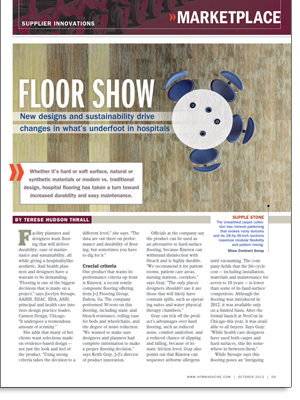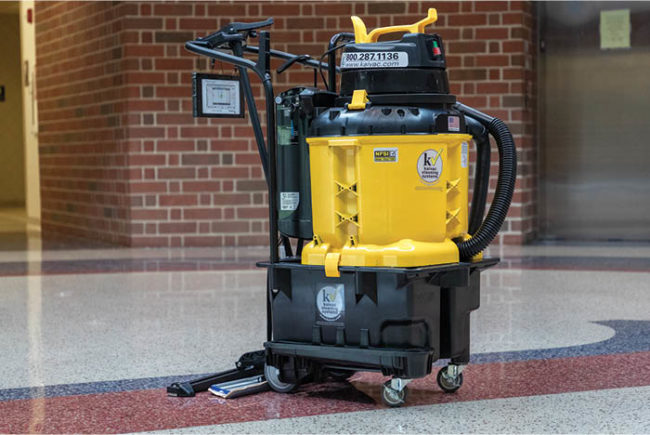
Facility planners and designers want flooring that will deliver durability, ease of maintenance and sustainability, all while giving a hospitalitylike aesthetic. And health planners and designers have a warrant to be demanding. "Flooring is one of the biggest decisions that is made on a project," says Jocelyn Stroupe, AAHID, EDAC, IIDA, ASID, principal and health care interiors design practice leader, Cannon Design, Chicago. "It undergoes a tremendous amount of scrutiny."
She adds that many of her clients want selections made on evidence-based design — not just the look and feel of the product. "Using strong criteria takes the decision to a different level," she says. "The data are out there on performance and durability of flooring, but sometimes you have to dig for it."
Crucial criteria
One product that wants its performance criteria up front is Kinetex, a recent textile composite flooring offering from J+J Flooring Group, Dalton, Ga. The company performed 30 tests on this flooring, including stain- and bleach-resistance, rolling ease for beds and wheelchairs, and the degree of noise reduction. "We wanted to make sure designers and planners had complete information to make a proper flooring decision," says Keith Gray, J+J's director of product innovation.
Officials at the company say the product can be used as an alternative to hard-surface flooring, because Kinetex can withstand disinfection with bleach and is highly durable. "We recommend it for patient rooms, patient care areas, nursing stations, corridors," says Gray. "The only places designers shouldn't use it are those that will likely have constant spills, such as operating suites and water physical therapy chambers."
Gray can tick off the product's advantages over hard flooring, such as reduced noise, comfort underfoot, and a reduced chance of slipping and falling, because of its static friction level. Gray also points out that Kinetex can sequester airborne allergens until vacuuming. The company holds that the life-cycle cost — including installation, materials and maintenance for seven to 10 years — is lower than some of its hard-surface competitors. Although the flooring was introduced in 2012, it was available only on a limited basis. After the formal launch at NeoCon in Chicago this year, it was available to all buyers. Says Gray: "While health care designers have used both carpet and hard surfaces, this fits somewhere in between them."
While Stroupe says this flooring poses an "intriguing idea," most of her clients are still opting for hard-surface flooring. "Hospitals are so challenged with managing the cost of their operating expenses, they need to be able to maintain floors quickly and easily, with a low number of FTEs. There's usually a limited window of time they can have access to a room or an area."
Maintenance simplified
Ease of maintenance comes with the flooring options offered by nora systems Inc., Salem, N.H. One advantage that nora's rubber flooring has over some vinyl counterparts is that it doesn't need to be coated and stripped, says Jim Bistolas, nora's national health care market segment manager. The rubber flooring from nora, including its two newest products, noraplan sentica and norament satura, can be cleaned with water only. "Not only does this simplify the process for the environmental services staff, but it creates a healthier place for patients with respiratory ailments and compromised immune systems," says Bistolas.
But rubber flooring's maintenance is not the only advantage it has for health care applications. Mannington Commercial, Calhoun, Ga., has seen an uptick in health care clients who want flooring with comfort underfoot and sound absorption, says Natalie Jones, vice president, commercial brand development and creative product. To fill this need, the company recently introduced ColorFields, its first rubber sheet flooring.
Jones adds that health care interior designers now are more sensitive to glare, and notes that rubber flooring can be buffed to whatever gloss level is desired or it can be left as a matte finish. "With the overhead lighting in hospitals, glare can contribute to staff fatigue," she adds.
Sustainability matters
Rubber flooring products also have "green" properties. Bistolas points out that nora's rubber flooring contains no harmful ingredients and emits zero volatile organic compounds, which makes for good indoor air quality, and contributes to a healing environment.
Using rubber flooring also can contribute to points for LEED certification, says Bistolas. "End users take a level of sustainability for granted now," he adds.
Stroupe agrees. "Even if designers for a facility are not trying to achieve LEED certification, they often want to follow LEED guidelines. We are always looking to find a sustainable product that will meet the needs of a client." She adds that often the products are available with renewable or recycled content that will fit the client's budget. "These products are often similarly priced [to unsustainable products]; there's usually no cost differential."
Jones notes that clients are looking more and more at the life cycle of a product, not just one facet of sustainability. "This includes such areas as raw material sourcing, the energy needed to produce the products, and a responsible end-of-life plan." Rubber flooring has much to offer in each of these areas, she adds.
Delivering durability
Because installing flooring is disruptive in a health care facility that's open 24 hours a day, seven days a week, durability is definitely a priority with health care facility planners, says Stroupe. "Flooring is expensive to replace, and it's also difficult to shut down an area to perform that work. Clients want to know that the flooring they choose can stay in place for a long time."
Durability is a strength of Marmoleum, a linoleum product manufactured by Forbo Flooring Systems, Hazelton, Pa. The company introduced the next generation of Marmoleum earlier this year, which features new color combinations and a flooring that has the look of concrete.
It's the components of Marmoleum — linseed oil, pine rosin and wood flour — that make it so durable, says Denis Darragh, Forbo's general manager. "Ten-year-old Marmoleum has a higher indentation resistance than new Marmoleum. Like concrete, it becomes harder and more durable over time," he notes.
Because the flooring can be recoated with Forbo's Topshield2, typically after it's been in place 10 to 15 years, it can last 30 years, Darragh says. "Interiors with Marmoleum are often redecorated before the product wears out," he adds, "so, many times it becomes the new subfloor."
But even though Marmoleum is strong, it's also biodegradable, made from rapidly renewable components, and contains inherent antimicrobial and antistatic properties. "Marmoleum checks many of the boxes that health care facilities seek today for flooring," Darragh adds.
Leading designs
Vendors note that flooring definitely is trending toward neutrals and earth tones, giving designers maximum flexibility to change wall colors or furnishings in the future. Shaw Contract Group, Cartersville, Ga., recently introduced the Unearthed carpet collection, which takes its colors from minerals and stone. The 18-by-36-inch carpet sections allow pattern mixing to create transition areas. Suited for atrium, reception and waiting areas, Unearthed is backed with the recyclable, non-PVC backing, EcoWorx.
Even hard surfaces are being influenced by textiles. For designers seeking sheet vinyl flooring with a textured look, Lonseal Inc., Carson, Calif., recently offered Loneco Linen. In neutral colors made of more than 50 percent recycled content, Loneco Linen features Topseal, a factory-applied urethane finish that protects the floor and simplifies maintenance.
Armstrong Commercial Flooring's Casablanca design in the Natural Creations luxury vinyl tile collection creates a damask-like visual that combines a textile feel with a unique printed pattern. "What's different about this tile is that it doesn't try to replicate wood, stone or ceramic," says Dominic Rice, vice president, sales and marketing, at Armstrong Commercial Flooring, Lancaster, Pa. "That gives the space a softer, warmer look, and designers can use it everywhere from lobbies to a patient room."
The Natural Creations palette contains earth-based neutrals in warm and cool tones. For ease of maintenance, the tile product features an abrasion-resistant wear layer. This UV-cured polyurethane coating can eliminate the need for polishes and spray buffing in some applications, saving customers time and money.
Another interesting visual is created with Amtico's Design Woods luxury vinyl tile. Rather than mimic the look of oak or cherry, the flooring captures woodlike visuals in striking shades and neutrals. "The patterns have the warmth of wood, but also are inspired by textiles — giving an abstracted wood look," says Jones at Mannington, owner of the Amtico brand.
Clients are installing these kinds of updated looks, says Stroupe. "We are seeing a trend toward a cleaner aesthetic," she says, "but the flooring still has patterning. After all, the floor is a big opportunity for a design statement."
Terese Hudson Thrall is a freelance health care writer based in the Chicago area and former associate editor for Health Facilities Management.
| Sidebar - For more information |
| For further details on the flooring products featured in this month's "Marketplace" article, readers can contact the following vendors: »Armstrong Commercial Flooring »Forbo Flooring Systems »Lonseal »J+J Flooring Group »Mannington Commercial »nora systems Inc. »Shaw Contract Group »Stonhard |





